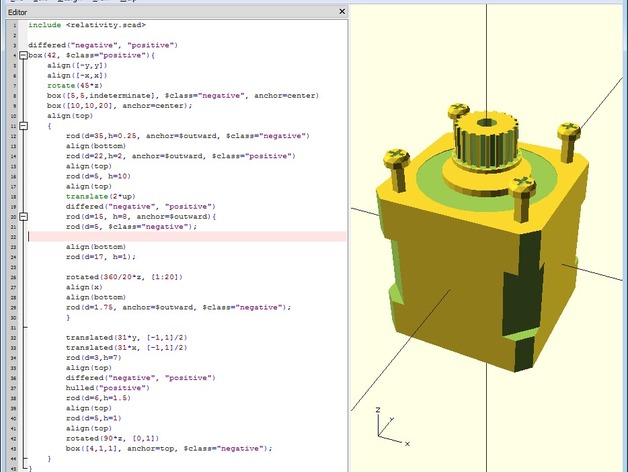
The Openscad General Library of Relativity
thingiverse
WikiRepo This OpenSCAD library adds functionality to size, position, and orient objects relative to other geometric primitives. To do so, the library introduces a new set of modules to replace the default geometric primitives in OpenSCAD. These new primitives have the ability to center themselves along any axis, and place their children along any border. So this: cube_h=10; cylinder_d=7; translate([0,0,cube_h/2]){ cube(cube_h, center=true); translate([cube_h/2 + cylinder_d/2,0,0]) cylinder(d=cylinder_d, h=cube_h, center=true); } becomes this: box(10, anchor=[0,0,-1]) align([1,0,0]) rod(d=7, h=$parent_size.z); But the library does more. Way more. The library does for OpenSCAD what css does for html. It seperates presentation from content. You can build a single module that renders every part of a project as it appears assembled, then create a presentation layer to isolate a printable part using show or hide. You can go the opposite way, too - you can define a series of components, then define attachment points for each and use attach to pop them into place like lego blocks. Similar modules exist for every CSG operation. The modules work with selectors to specify the primitives you want to work with, much like css or jquery: //OpenSCAD logo: differed("hole") ball(50) orient([x,y,z]) rod(d=25, h=50, $class="hole"); For more information, check out the wiki! Updates 1/25/16 Took down the link to the 2014.03 compatible version, since it was causing confusion. 11/26/15 Added new CSS-like operations: colored(), resized(), and scaled(). Also, fixed an issue causing selectors to not correctly interpret parent-child relationships. 3/17/15: relativity.scad has been updated to make use of new functionality in the 2015.03 version of OpenSCAD. relativity.scad is no longer compatible with OpenSCAD version 2014.03. If you wish to continue using 2014.03, the older version of relativity.scad is still available under the Downloads section as "relativity.2014.03.scad" 2/14/15: Implemented support for parent/child and ancestor/descendant relationships in the selector engine. Selectors now enforce whitespace sensitivity. A useful new module has been added, attach(). This module allows you to invoke the children() operator multiple times throughout a module, then specify which instance of children() you want to attach to. There is a new demo on the wiki that demonstrates this functionality 1/19/15: CSG operations can now be assigned a value for $class. This enables them to be used by other CSG operations higher up the call stack. differed() now accepts positive as an optional parameter that defaults to the opposite of negative. Two selector based operations have been introduced, show() and hide(), with obvious functionality. 12/25/14: Relativity now borrows code from the String Theory library. This enables advanced class selectors in CSG operations such as negation and class union, e.g. hulled("not(foo)") or hide("this,that"). Syntax for these operations are intended to match documentation for existing standards used in web development. Details are available on the wiki 10/31/14: construct has been renamed to differed, which now works through a $class parameter much like the class attribute of html. Other modules similar to construct have been added, including hulled and intersected. Two new parameters were added, $inward and $outward, which represent vectors towards and away from the center of the parent object. The anchor parameter now defaults to $inward. Miscellaneous functions such as mill and slice are now depreciated. Check the wiki for more details. 9/7/14: Attempts to align objects to parents of indeterminate size will result in no translation having occurred. This is to address situations where objects would accidentally become lost from sight. Moved morphological functions to a secondary file, morphology.scad. Added a very useful new function, construct 8/23/14: Diameter and height parameters for rod default to indeterminate 8/20/14: The visible parameter within geometric primitives has been replaced by a special variable, $show. The use of a special variable makes it much easier to use existing complex geometries as place holders when positioning other objects. $show is chosen over $visible as I find the variable is used frequently enough to require shortening the length of its name. 8/18/14: Addressed some issues resulting from the interaction of box, rod, and orientation. Parameters for mill() have been modified to better express through holes and to allow specification for the direction of cut. 7/24/14: added orientation parameter to geometric primitives, simplifying situations where you need to rotate cylinders without disturbing the rotation of their children. Instructions Place relativity.scad in your local OpenSCAD folder under /libraries On Windows, this folder should default to Documents/OpenSCAD/libraries. Import relativity.scad with the following line of code: include For full documentation, check out the up and coming wiki: https://github.com/davidson16807/relativity.scad/wiki
With this file you will be able to print The Openscad General Library of Relativity with your 3D printer. Click on the button and save the file on your computer to work, edit or customize your design. You can also find more 3D designs for printers on The Openscad General Library of Relativity.
